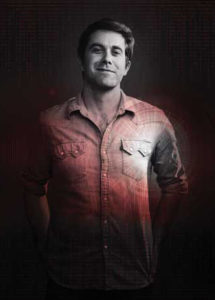
Chris Rogers ’05 is co-creator of the critically acclaimed TV series Halt and Catch Fire.. In April, the show’s fourth season was nominated for a Peabody Award.
Photo by James Minchin/AMC.
By Edie Gross
Chris Rogers ’05 and his writing partner, Christopher Cantwell, had already pitched their TV show to HBO and Showtime. In each case, an executive had politely offered them bottled water and listened to their spiel before ushering them out with a handshake and a halfhearted pledge to keep in touch.
But the meeting at AMC felt decidedly different. For starters, they weren’t perched on a couch in someone’s office, but rather ushered into a conference room. There, a team of executives gathered, each with a copy of the script Rogers and Cantwell had spent months fine-tuning. As the meeting ended, AMC asked the writers to return with a “bible,” an industry term for a document that establishes the characters, setting, and story arc for a fictional universe.
“We kind of exchanged a glance: ‘This is good, right?’ ” recalled Rogers of that meeting in 2013.
Quite good, in fact. The pair’s creation, Halt and Catch Fire, wrapped up a four-season run on AMC in October 2017 after earning a fiercely loyal following and rave reviews from the likes of Forbes, The New York Times, Rolling Stone, and The A.V. Club – all of which hailed the final season as some of the best television of 2017. It was nominated in April for a Peabody Award; the winner will be announced on May 19. The period drama is now streaming on Netflix, much to the delight of binge-watchers everywhere.
The characters in the show are fictional, but the setting – the intensely competitive arena that gave rise to the personal computing industry – derives from “good old history research,” said Rogers, who studied history at Mary Washington.
“More than anything, that major teaches you to process a lot of information and separate the important stuff from the not-so-important,” Rogers said. He co-created the show after carefully researching the real-life efforts of tech-savvy mavericks in the 1980s to reverse engineer an IBM computer, thereby toppling the industry’s undisputed leader.
Halt and Catch Fire fans don’t need to be conversant in computers to enjoy the show, any more than viewers of AMC’s Mad Men had to understand the advertising industry. At its heart, the series is a tale of scrappy underdogs taking on the establishment while clashing with one another over creative differences. But the accuracy of the show’s historical backdrop helps amplify the connection fans have to the characters and their fates.
“When you find the story people think they know, that’s when you hit dramatic pay dirt,” Rogers said.


Rogers grew up in Winchester, Virginia, and was always a fan of a good story, said his mother, Jan Rogers. He carried a book and a pocket dictionary everywhere he went. He wrote constantly, filling journals he stored beneath his bed. One summer, while he worked construction, he read only Russian novels.
“That’s not a normal 20-year-old activity,” said his mother, a middle school math teacher.
Jan Rogers said she was thrilled when her oldest child chose UMW, in part for its small professor-to-student ratio. His younger siblings, David Rogers ’08 and Abbie Rogers ’13, followed suit.
At UMW Rogers declared himself a philosophy major, until enrolling in Professor William B. Crawley’s course on the American South. Rogers said he enjoyed interacting with his history professors as much as he did studying the subject matter.
“I fell in love with the personalities as well as the classes. I felt like I found my people,” Rogers said. The historical accounts he studied “were like the stories I loved from literature, but true, and so often about ordinary people who are placed in extraordinary situations.”
He lived in the apartments on Sunken Road; he joined crew and the debate team. Ten years later, he was back for reunion.
“It was one of those places where you really made your own experience,” Rogers said of Mary Washington. “Some days, I can’t stand the fact that it ended.”
____________
After graduation, Rogers considered going to law school but realized his heart wasn’t in it. It was, instead, in writing – something he rediscovered at UMW in a class taught by the late poet Claudia Emerson. So he wrote a “love letter” to The Atlantic magazine in Washington, D.C., which hired him as a writing and research assistant. He lived in Adams Morgan with what he called an “inspiring community of people,” slightly older professionals who challenged him to pursue his passion for writing in earnest.
So Rogers packed a suitcase and, with $800 to his name, moved to Los Angeles. He crashed on the West Hollywood couch of a friend of a friend while attending night classes in screenwriting.
“It was the making of me,” Rogers recalled. “God bless the naiveté of it. It was immediately a bad plan when I hit the ground, but going back would’ve required so much swallowing of pride that I stuck it out.”
He supported himself through temp jobs, then “hustled” his way into a post at LA Confidential magazine, which led to a position at Architectural Digest. When Condé Nast downsized the publication’s West Coast offices, Rogers went to work for Disney, organizing and managing social media content.
An early riser since his days as a cross country runner in high school, Rogers would get up at 5 a.m. and write each morning before heading to the office. “With screenwriting, like all writing, the only way to get better at it is to write a lot of sh–ty scripts. It would be years before anyone read me seriously,” Rogers said.
About a year into the job at Disney, he and boss Christopher Cantwell went out for a beer at a dive bar, where each revealed to the other his dream of becoming a screenwriter. Cantwell was primarily interested in movies, but Rogers, a huge fan of David Simon’s The Wire, said he felt TV had the best screenwriting he’d seen. He and Cantwell agreed to collaborate on a TV script, and though their first project wasn’t picked up, industry insiders encouraged them to try again.
Their second effort was Halt and Catch Fire, which gets its name from an old computer command that essentially forced all of the machine’s instructions to compete for superiority at once before causing a shutdown. After months of back and forth, AMC executives called to say they were picking up the show. Could Rogers
and Cantwell be in Atlanta in a week to scout filming locations?
“It was really slow, and then it was really fast,” said Rogers, who celebrated the news with Cantwell and friends at the same dive bar where they’d forged their partnership. “You go through the looking glass quickly.”
At the time, Rogers knew little about all the logistics that go into filming a TV series, from building sets and securing locations to casting actors and choosing a soundtrack. He quickly learned that being a “showrunner” is about listening to good advice and letting others contribute to the vision.
The writers he and Cantwell worked with only strengthened the scripts, and the actors gave the characters more depth than they’d had on paper, he said. It didn’t hurt that AMC partnered with Gran Via Productions, founded by University of Virginia grad Mark Johnson, who had also worked on AMC’s Breaking Bad and its spinoff, Better Call Saul.
“It’s a collaborative medium,” said Rogers, who named his production company Sic Semper Tyrannis after his love for Virginia. “In success, I think there’s a lot of people who make me look good.”
The show aired on June 1, 2014, two weeks after first streaming on AMC’s Tumblr page, the first series to ever premiere on the social networking website. Before that, Rogers’ parents, Jan and Chuck Rogers, attended the big-screen sneak preview in Los Angeles.
“He turned to me and said, ‘I got my goal I set with those guys back in Adams Morgan.’ I’m choked up thinking about it now,” Jan Rogers said of her son. “It was surreal to be sitting in a movie theater. This is a mom thing – my husband and I would count how many times his name would appear on the screen. We’d clap after every time, and we did that even in our own home when we watched the show.”
Rogers views the first season as the most technical of the bunch, and critics seemed to agree. When AMC renewed the show for a second season, Rogers and Cantwell agreed to swing for the fences.
“As much as the first season was about figuring out where we were going, we wrote the second season like it was our last – if we never get to do it again, this is the story we want to tell.”
Critics noticed, including The New Yorker’s Emily Nussbaum, who called the second season “a startling upgrade” of the first. Seasons 3 and 4 were similarly well received, with the final season scoring a 100 percent among critics on the online review site Rotten Tomatoes.
Filming wrapped up about three weeks after Rogers’ wife, Meghan, gave birth to their first child, Maureen. Rogers said he’s enjoying spending more time with his wife and daughter while working on new projects from their home in Los Angeles’ Silver Lake neighborhood. A movie about the history of ESPN, starring Steve Carell, is a solo project. And he and Cantwell are writing another show for AMC.
“He likes good stories. He’s read good stories, and that’s what he wants to be known for: telling a good story,” his mother said. “He’s a very happy man. Chris got his thing. As a parent, that’s the part that makes me the happiest.”



